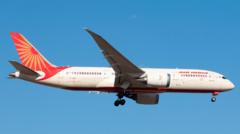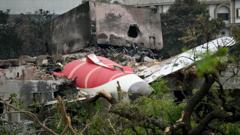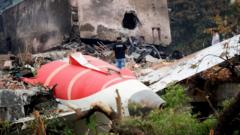The investigation into Air India Flight 171, which crashed shortly after take-off in Ahmedabad, is revealing complex challenges. With both cockpit voice and flight data recorders recovered, experts are examining various potential causes, including engine performance, maintenance records, and pilot actions.
Investigating the Air India Flight 171 Tragedy: New Clues and Challenges

Investigating the Air India Flight 171 Tragedy: New Clues and Challenges
As the investigation unfolds into the Air India crash, experts analyze crucial components and data to uncover the cause behind this aviation disaster.
The Air India Flight 171 tragedy has sparked a thorough investigation following its catastrophic crash shortly after take-off in Ahmedabad. Last week, the Boeing 787 lost altitude and crashed into a densely populated neighborhood, marking one of India’s rare aviation disasters. Within less than 40 seconds of take-off, the aircraft, carrying 242 people, prompted a mayday call before descending rapidly.
As investigators work to determine the cause, they are focusing on the flight data and cockpit voice recorders, essential tools that will aid in uncovering the sequence of events. International regulations mandate a preliminary report within 30 days, and a final report typically is completed within 12 months following such disasters.
Initial speculation about the crash centers around several possibilities, including potential engine failure due to bird strikes or fuel contamination, improper extension of the flaps, or a crew error. Captain Kishore Chinta, a former investigator with India’s Aircraft Accident Investigation Bureau (AAIB), labeled this crash as "the rarest of the rare," noting the unusual scenario of a controlled flight into terrain just after take-off.
As investigators sift through the wreckage, they are looking closely at the two engines for clues. Peter Goelz, a former US National Transportation Safety Board managing director, emphasized that how the turbines are fractured can determine whether they were producing power during the crash.
The recovered "black boxes" will provide critical insights; they not only capture detailed flight data but also sounds from the cockpit that may reveal during the crucial moments leading up to the crash. Flaps and slats, essential for lift during take-off, will also be scrutinized, as their operational state can drastically shift the focus of the investigation.
The investigation is further complicated due to the need for comprehensive maintenance records from Air India and the examination of potential systemic issues affecting the Boeing 787 fleet. While there are currently no indications of fault, a meticulous examination of maintenance logs, pilot training records, and other documentation will take place.
As investigators collect evidence piece by piece, the advanced technology of today greatly aids their efforts. Modern flight data recorders provide a rich stream of parameters and data points, offering a more extensive analysis than in past investigations.
Ultimately, while early indicators may emerge, fully understanding the “why” behind this aviation disaster will take considerable time and effort. With collaborative input from multiple agencies and technology at their disposal, investigators are poised to unravel the details surrounding Air India Flight 171.






















